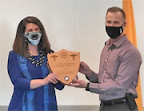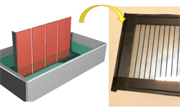Perseverance begins its science on Mars with a laser zap
SuperCam before it was mounted on Perseverance, CNES photo.
Perseverance has already made its mark on scientific history by taking the first audio recording ever on Mars. But the instrument with the microphone, known as the SuperCam, wasn’t done there.
SuperCam itself is the brainchild of scientists at Los Alamos National Laboratory and a consortium of European research universities with the French Centre National d’Etudes Spatiales (CNES) leading the way.
There are 5 main recording instruments integrated into the SuperCam that accomplish its primary mission of understanding the chemical makeup of rocks and soil. These instruments include the microphone, a visible and infrared sensor (VISIR), and a Raman spectrometer, which uses a green laser to zap rocks and analyze the signal emitted from the chemical bonds the laser zap breaks. (Full Story)
LANL scientist studies sounds on Mars
Wiens on KRQE-TV.
A scientist from Los Alamos National Lab is studying sounds on Mars. Sound is recorded through the super cam on Mars Rover Perseverance. Roger Wiens’ job is to investigate those sounds at the lab. Through the Super Cam, they can listen to the sound of the wind, the rover moving, and the sound of a laser being fired at rocks.
That simple sound tells Wiens a lot about the Red Planet that was previously unknown. “That light that we get back from these laser techniques tells us a lot about the property of rocks. (Full Story)
Integrating diverse satellite images sharpens our picture of activity on Earth
Imagery from ESA's Sentinel-1 satellite shows flooding (red) in Mozambique, ESA image.
At Los Alamos National Laboratory, we've developed a flexible mathematical approach to identify changes in satellite image pairs collected from different satellite modalities, or sensor types that use different sensing technologies, allowing for faster, more complete analysis. It's easy to assume that all satellite images are the same and, thus, comparing them is simple. But the reality is quite different. Hundreds of different imaging sensors are orbiting the Earth right now, and nearly all take pictures of the ground in a different way from the others. (Full Story)
Solving ‘barren plateaus’ is key to quantum machine learning
Many machine learning algorithms on quantum computers suffer from the dreaded "barren plateau" of unsolvability, where they run into dead ends on optimization problems. This challenge had been relatively unstudied -- until now. Rigorous theoretical work has established theorems that guarantee whether a given machine learning algorithm will work as it scales up on larger computers.
“The work solves a key problem of useability for quantum machine learning,” said Marco Cerezo, lead author on the paper published in Nature Communications today by a Los Alamos National Laboratory team. (Full Story)
Also from HPC Wire
New class of versatile, high-performance quantum dots primed for medical imaging, quantum computing
New class of quantum dots excel as single-photon emitters, LANL photo.
A new class of quantum dots deliver a stable stream of single, spectrally tunable infrared photons under ambient conditions and at room temperature, unlike other single photon emitters. This breakthrough opens a range of practical applications, including quantum communication, quantum metrology, medical imaging and diagnostics, and clandestine labeling.
"The demonstration of high single-photon purity in the infrared has immediate utility in areas such as quantum key distribution for secure communication," said Victor Klimov, lead author of a paper published today in Nature Nanotechnology by Los Alamos National Laboratory scientists. (Full Story)
How single particles of light can protect power grids
Quantum physicist Raymond Newell,LANL photo.
As hackers increasingly try to infiltrate our computer-dependent systems—even those that direct energy into homes—a new method of encrypting information could end this risk.
Rather than running this race by developing more and more complex codes, for the past eight years Los Alamos National Laboratory has developed a new method for protecting information sent through the nation's grid system called Quantum Ensured Defense (QED). Instead of math, this method is based on immutable laws of physics and uses single particles of light, or photons, to protect information. (Full Story)
What's the difference between rational and irrational numbers?
In the technologically advanced 21st century, irrational numbers continue to play a crucial role, according to Carrie Manore. She's a scientist and a mathematician in the Information Systems and Modeling Group at Los Alamos National Laboratory.
"Pi is an obvious first irrational number to talk about," Manore says via email. "We need it to determine area and circumference of circles. It's critical to computing angles, and angles are critical to navigation, building, surveying, engineering and more. Radio frequency communication is dependent on sines and cosines which involve pi." Additionally, irrational numbers play a key role in the complex math that makes possible high-frequency stock trading, modeling, forecasting and most statistical analysis — all activities that keep our society humming. (Full Story)
New manufacturing tech for 16.06%-efficient mini perovskite solar modules
Mini perovskite module, LANL image.
A group of scientists from the US Department of Energy's Los Alamos National Laboratory and the National Taiwan University (NTU) has developed a new manufacturing process for mini perovskite solar modules that is claimed to overcome key bottlenecks in large-scale production.
The research group has created a new spin coating method which they claim can be applied in the mass production of mini perovskite panels. The scientists used sulfolane as an additive in the perovskite precursor to convert the perovskite phase via a new reaction route. (Full Story)
Next-generation technologies for biofuels refining
Smart Chutes discards problematic biomass material with high-moisture content, from J&J.
A collaboration between Los Alamos National Laboratory and Jenike & Johanson, a bulk solids storage company, and funded by the U.S. Department of Energy Bioenergy Technologies Office through the Feedstock-Conversion Interface Consortium, has developed new technologies, called Smart Transfer Chutes, with integrated acoustic moisture sensors that greatly improve the operational reliability of biorefineries.
“The Achilles heel of biorefineries is the operational reliability,” said Troy Semelsberger, a senior research scientist at Los Alamos National Laboratory. “Currently the operational reliability of biorefineries is estimated to be around 30 percent, meaning that for 70 percent of the year they have to stop operation." (Full Story)
Los Alamos team develops CICE software package for modeling changes in sea ice
The complexity of variables at play in sea-ice physics, LANL graphic.
With funding from the Department of Energy, a Los Alamos National Laboratory team developed a software package known as CICE that calculates the complex physics of sea ice, such as how it freezes, melts, and moves across the ocean’s surface, and how it is influenced by external forces such as the ocean’s currents and winds. Research and forecasting organizations in more than 20 countries have incorporated CICE into their work. The software program is managed by the CICE Consortium, an international group of institutions formed to maintain and develop CICE in the public domain. (Full Story)
Also from the LA Reporter this week:
Astrophysicist Nicole Lloyd-Ronning inspires science in future generations across Northern New Mexico
Nicole Lloyd-Ronning leads an activity forthe Santa Fe Indian School, LANL photo.
On a clear summer evening, Nicole Lloyd-Ronning of Los Alamos National Laboratory’s Computational Physics and Methods group steps outside her house and looks at the stars in the sky. She imagined herself one day venturing into outer space and exploring the moon and the planets beyond.
Lloyd-Ronning’s outreach includes PASEO 2018: Indigenous Cosmology Meets Particle Physics Youth Workshop, STEMarts Lab, the program Agnes Chavez founded to deliver sci-art installations and STEAM (science, technology, engineering, arts, and math) programming for schools, art and science organizations, festivals, and events. (Full Story)
And:
Lindquist and Pasqualoni receive Los Alamos Public Safety Association awards
Dr. Sara Pasqualoni awarded by the Los Alamos Public Safety Association, LAPSA photo.
The Los Alamos Public Safety Association has presented Public Safety Dedication Awards to Dr. Beth Lindquist and Dr. Sara Pasqualoni, Medical Director for Los Alamos National Laboratory.
As the Los Alamos National Laboratory (LANL) Medical Director, Dr. Pasqualoni has worked diligently and tirelessly to protect the health and safety of all LANL personnel since the inception of the COVID-19 pandemic. In the beginning stages of the pandemic, she had the vision and foresight to establish and chair a LANL Pandemic Advisory Team. (Full Story)
To subscribe toLos Alamos Press Highlights, please e-maillistmanager@lanl.govand include the wordssubscribe PressHighlightsin the body of your email message; to unsubscribe, includeunsubscribe PressHighlights.
Please visit us at www.lanl.gov


















































